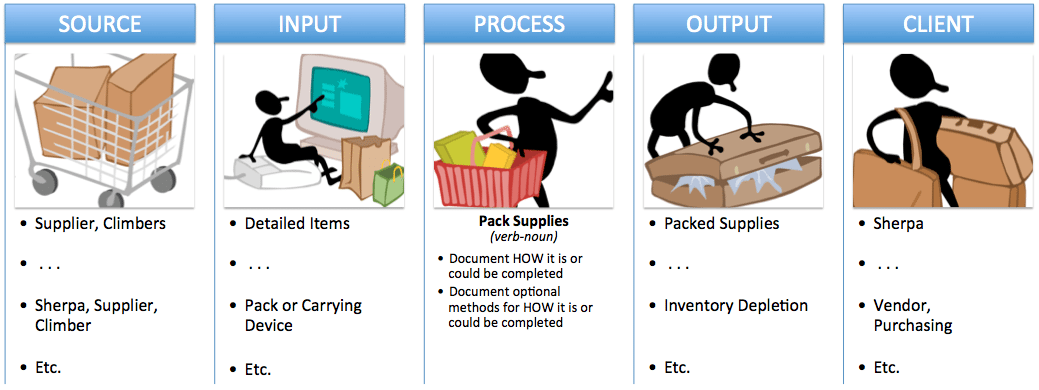In the role of facilitator, you will discover a lot of power by using metaphors or analogies to explain your method. Avoid using the content and experience of the subject matter experts. In other words, a metaphor is worth a thousand pictures.
To use “their” content violates neutrality. Use a metaphor or analogy about which you have passion. A metaphor helps you to explain it to your great-grandmother, the test of ultimate clarity. In the following example, we use “Mountain Climbing” to explain one form of a USE CASE, called SIPOC (i.e., Source, Input, Process, Output, and Client/Customer).
Previously completed work that helped to identify some of the “requirements” could have led us to understand that one of the activities required to support the purpose of mountain climbing has been identified as “pack supplies” (note the simple verb-noun pairing). Rather than explain the SIPOC tool orally, we can provide a picture or illustration of the tool by using the metaphor or analogy of mountain climbing.
Right-to-Left Thinking
The phrase “right to left thinking” (similar to “start with the end in mind”) derives from SIPOC. There are five discrete activities, namely:
- Anchor the framework with the activity or process, here previously identified as “Pack Supplies”. Since subject matter experts (aka SMEs) perform similar tasks differently, socialize and document how the activity is or should be performed, allowing for multiple perspectives. Later, take this material and transpose or append it to process flow diagrams or swimlanes.
- Identify the outputs or things that result from the completed activity. A “thing” could be information, a transaction, or a tangible item. Think of a “thing” as a noun such as a person, place, or object about which we need more information to make an informed decision.
- For each discrete output, discuss where it goes or who is the client or customer of the output. Note there could be more than one client for each output. For example, information called “Inventory Depletion” is shared with both the purchasing role so that they can reorder and perhaps the vendor to enable auto-replenishment.
- Working to the left side, identify the things needed to complete the activity.
- Finally, identify the source(s) of each thing, noting again that there could be multiple sources for a single item. The “Pack” for example, might come from the sherpa, supplier, or even the climber.
By using an illustrative analogy you can now explain to your meeting participants where you are in the agenda and how the agenda steps support one another. Using an analogy reinforces that your role remains content-neutral. The analogy makes abstract terms such as “input” concrete or tangible and more easily understood. Remember, a metaphor is worth a thousand pictures.
______
Don’t ruin your career by hosting bad meetings. Sign up for a workshop or send this to someone who should. MGRUSH workshops focus on meeting design and practice. Each person practices tools, methods, and activities every day during the week. Therefore, while some call this immersion, we call it the road to building high-value facilitation skills.
Our workshops also provide a superb way to earn up to 40 SEUs from the Scrum Alliance, 40 CDUs from IIBA, 40 Continuous Learning Points (CLPs) based on Federal Acquisition Certification Continuous Professional Learning Requirements using Training and Education activities, 40 Professional Development Units (PDUs) from SAVE International, as well as 4.0 CEUs for other professions. (See workshop and Reference Manual descriptions for details.)
Want a free 10-minute break timer? Sign up for our once-monthly newsletter HERE and receive a timer along with four other of our favorite facilitation tools, free.

Terrence Metz, president of MG RUSH Facilitation Training, was just 22-years-old and working as a Sales Engineer at Honeywell when he recognized a widespread problem—most meetings were ineffective and poorly led, wasting both time and company resources. However, he also observed meetings that worked. What set them apart? A well-prepared leader who structured the session to ensure participants contributed meaningfully and achieved clear outcomes.
Throughout his career, Metz, who earned an MBA from Kellogg (Northwestern University) experienced and also trained in various facilitation techniques. In 2004, he purchased MG RUSH where he shifted his focus toward improving established meeting designs and building a curriculum that would teach others how to lead, facilitate, and structure meetings that drive results. His expertise in training world-class facilitators led to the 2020 publication of Meetings That Get Results: A Guide to Building Better Meetings, a comprehensive resource on effectively building consensus.
Grounded in the principle that “nobody is smarter than everybody,” the book details the why, what, and how of building consensus when making decisions, planning, and solving problems. Along with a Participant’s Guide and supplemental workshops, it supports learning from foundational awareness to professional certification.
Metz’s first book, Change or Die: A Business Process Improvement Manual, tackled the challenges of process optimization. His upcoming book, Catalyst: Facilitating Innovation, focuses on meetings and workshops that don’t simply end when time runs out but conclude with actionable next steps and clear assignments—ensuring progress beyond discussions and ideas.




